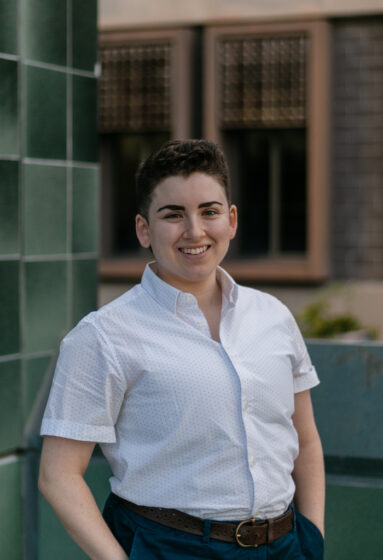Social justice fellows spread their wings
After finding community at CED, the first cohort of ASJC graduates makes an impact.

When the Arcus Social Justice Corps (ASJC) launched in 2021, the COVID-19 pandemic was raging at full force and the College of Environmental Design’s (CED) doors were closed. The program, a graduate fellowship funded by a gift from Jon Stryker (MArch 1989), had set out with a clear mission: ASJC would provide these professional master’s students with significant tuition assistance and help them identify ways to apply what they learned in Bauer Wurster Hall to a community service setting. In exchange, they would commit to spend three years doing social impact work following graduation.
But the pandemic threw roadblocks in front of plans for engaging directly with communities. Instead, Elizabeth Bowler, the program’s manager, honed in on the idea that the fellowship is uniquely positioned to connect fellows from across CED with one another to explore social impact–focused action and unpack what effective community participation actually looks like.
“We hosted a virtual lecture series with CED alums about their social justice careers, which gave fellows opportunities to ask speakers questions about the realities and barriers they face in this work and how they got a seat at the table,” Bowler says. Bowler also created other virtual events for the fellows to come together as a group with a common mission.
Back in person, ASJC now integrates even more programming to include collaborations between organizations like Cafe Ohlone and the Bay Area Mural Program, thanks to connections from new faculty director, Karen Trapenberg Frick.
For some of the program’s fellows, that emphasis on social impact was a breath of fresh air. Mario Devora (MArch 2022) graduated with ASJC’s first cohort. Before his time at CED, he worked for private architecture firms, an experience he found disheartening. Those firms, he discovered, didn’t pursue work that had real input from and bearing on communities.
At CED, ASJC introduced Devora to fellows from disparate parts of Bauer Wurster Hall, spurring conversations that otherwise might never have taken place. Those conversations solidified for Devora a sense that “the idea of helping others can be implemented into architecture,” which became crucial to his practice after graduating.
ASJC’s goal, to relieve students of financial burden, put a social-service career within Devora’s reach. Without the pressures of student loan debt, he was able to pursue more impactful work rather than having to accept only the highest-paying job.
Currently, Devora works for a small architecture firm in Albuquerque, New Mexico, that prioritizes public projects. On the side, he helps out with a mentorship program that pairs community college students with working professionals, with the goal of increasing the number of those students who pursue architecture degrees at four-year universities.
He also sits on two advisory committees in the University of New Mexico’s School of Architecture and Planning, where he teaches a second-year studio course. The committees’ discussions have focused on internal revitalization and ways to rehaul the ideas and values that the school holds — conversations that recall the ones he had with his ASJC cohort.
“Just having the name Arcus, something talking about social justice, has been invaluable,” Devora says. “The name has been a conversation starter in many places: ‘What does social justice actually mean?’”
Eleanor Mayes (MDes 2023), who, like Devora, was part of the program’s first cohort, agrees that ASJC’s role in connecting students across CED programs was essential to the work she does now.
“ASJC’s emphasis on intersectionality and working with peers from different CED programs provided me with extremely valuable perspectives and connections,” Mayes explains.

While she was a student, Mayes spent a summer applying her design and engineering skills to challenges faced by the blind community. ASJC sponsored the project, which gave Mayes first-hand knowledge of “the ways that our physical environment and urban infrastructure can neglect those who are blind or low-vision.”
ASJC encouraged Mayes to advocate for the causes she believed in. After graduating, Mayes went on to work with Joshua Miele, a local Macarthur Fellow who researches accessible technology for blind makers and the broader blind community.
“The diversity of Arcus and its fellows,” Mayes explains, “mirrors the intersectionality of life beyond CED.”
For Bowler, ASJC is all about laying the groundwork for fellows to grow from students into leaders who apply the skills they learned at CED to serve communities. “It’s been extraordinary to consider what comes next for this group.”